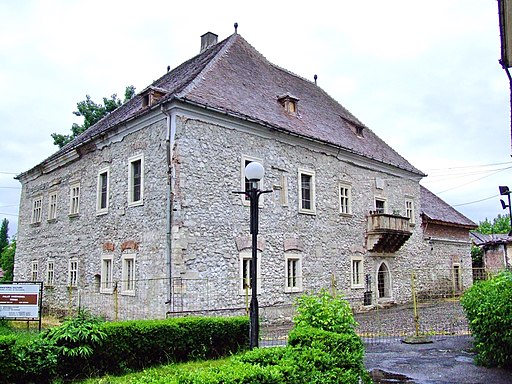Salt Chamber House, Palace of the Princes of Transylvania, Museum of Torda
Salt Chamber House, Palace of the Princes of Transylvania, Museum of Torda
Original function:
public administration
palace
Address:
Strada Bogdan Petriceicu Hașdeu 2
Historical Hungarian county:
Torda-Aranyos
GPS coordinates:
46.5719796842, 23.7845234547
History
Torda was already the centre of a royal county in the 11th century. Due to its favourable location, Torda became a key settlement in Transylvanian public affairs. The Keresztesmező near the town was the main gathering place for noble troops. The vajda of Transylvania delivered justice here, and most of the meeting of the Estates were alsa held here.
Records of salt mining in Torda date back to 1075. The salt chamber existed already in the 14th century. It was the first among the Transylvanian salt chambers, and the royal chamberlain of Torda, who was superior to the other chamberlains, held the title of ispán (comes camerae). The salt mines in the area supplied the majority of Hungary's salt needs.
The earliest part of the salt chamber house, the tower, which also serves as a defence, was built in the early 15th century. It was enlarged in the early 16th century. The first mention of the salt chamber house dates back to 1524. As a treasury property, it also served as accommodation for the King of Hungary and later, especially during the Diets, for the Transylvanian princes. In 1540, King John I of Hungary received here the oath of allegiance of the Transylvanian lords. At the end of the 16th century (between 1581 and 1594), Prince Báthory Zsigmond of Transylvania expanded it into a representative princely residence. The Renaissance door and window frames date from this period. It was restored in 1818. After the Hungarian Revolution of 1848, the salt chamber was moved from Torda, first to Nagyszeben, then to Kolozsvár and finally to Marosújvár in 1880. In 1883, the large gate was demolished on the grounds of danger. In 1887, the main front balcony supported by pillars disappeared. In 1907 it was inaugurated as a House of Culture. Between 1909 and 1912 a major renovation was carried out on the basis of plans by the architect Lux Kálmán. It houses a history museum.
The core of the museum's collection was donated by local people. The most significant collection was given by Téglás István, but a lot of material was also collected in the former main grammar school. In 1943, the Museum Society was founded with the aim of bringing the collections together in a museum. The museum opened in 1951 in the former salt chamber house.
The 3X4 m painting painted by Krisch Aladár in 1898 on the religious freedom of the Transylvanian churches was exhibited in the museum. The painting was previously held in the main Catholic church.
{"item":"sight","set":{"sightId":1516,"townId":63,"active":2,"name_LO":"","address":"Strada Bogdan Petriceicu Ha\u0219deu 2","mapdata":"1|1401|1575","gps_lat":"46.5719796842","gps_long":"23.7845234547","religion":0,"oldtype":"15,50","newtype":"98","homepage":"https:\/\/muzeulturda.com\/","openinghours":"","muemlekemlink":"https:\/\/www.muemlekem.hu\/hatareset\/Sokamarahaz-Torda-1771","csemadoklink":"https:\/\/lexikon.adatbank.transindex.ro\/muemlek.php?id=376","picture":"\u003Ca title=\u0022CristianChirita, CC BY-SA 3.0 RO \u003Chttps:\/\/creativecommons.org\/licenses\/by-sa\/3.0\/ro\/deed.en\u003E, via Wikimedia Commons\u0022 href=\u0022https:\/\/commons.wikimedia.org\/wiki\/File:2006_0602Palatul_voievodalTurdaCJ-II-m-A-07794.jpg\u0022\u003E\u003Cimg width=\u0022512\u0022 alt=\u00222006 0602Palatul voievodalTurdaCJ-II-m-A-07794\u0022 src=\u0022https:\/\/upload.wikimedia.org\/wikipedia\/commons\/thumb\/f\/f0\/2006_0602Palatul_voievodalTurdaCJ-II-m-A-07794.jpg\/512px-2006_0602Palatul_voievodalTurdaCJ-II-m-A-07794.jpg\u0022\u003E\u003C\/a\u003E","picture_ref":"\u003Ca href=\u0022https:\/\/commons.wikimedia.org\/wiki\/File:2006_0602Palatul_voievodalTurdaCJ-II-m-A-07794.jpg\u0022\u003ECristianChirita\u003C\/a\u003E, \u003Ca href=\u0022https:\/\/creativecommons.org\/licenses\/by-sa\/3.0\/ro\/deed.en\u0022\u003ECC BY-SA 3.0 RO\u003C\/a\u003E, via Wikimedia Commons","name":"Salt Chamber House, Palace of the Princes of Transylvania, Museum of Torda","note":"","history":"Torda was already the centre of a royal county in the 11th century. Due to its favourable location, Torda became a key settlement in Transylvanian public affairs. The Keresztesmez\u0151 near the town was the main gathering place for noble troops. The vajda of Transylvania delivered justice here, and most of the meeting of the Estates were alsa held here.@\nRecords of salt mining in Torda date back to 1075. The salt chamber existed already in the 14th century. It was the first among the Transylvanian salt chambers, and the royal chamberlain of Torda, who was superior to the other chamberlains, held the title of isp\u00e1n (comes camerae). The salt mines in the area supplied the majority of Hungary's salt needs.@\nThe earliest part of the salt chamber house, the tower, which also serves as a defence, was built in the early 15th century. It was enlarged in the early 16th century. The first mention of the salt chamber house dates back to 1524. As a treasury property, it also served as accommodation for the King of Hungary and later, especially during the Diets, for the Transylvanian princes. In 1540, King John I of Hungary received here the oath of allegiance of the Transylvanian lords. At the end of the 16th century (between 1581 and 1594), Prince B\u00e1thory Zsigmond of Transylvania expanded it into a representative princely residence. The Renaissance door and window frames date from this period. It was restored in 1818. After the Hungarian Revolution of 1848, the salt chamber was moved from Torda, first to Nagyszeben, then to Kolozsv\u00e1r and finally to Maros\u00fajv\u00e1r in 1880. In 1883, the large gate was demolished on the grounds of danger. In 1887, the main front balcony supported by pillars disappeared. In 1907 it was inaugurated as a House of Culture. Between 1909 and 1912 a major renovation was carried out on the basis of plans by the architect Lux K\u00e1lm\u00e1n. It houses a history museum.@\nThe core of the museum's collection was donated by local people. The most significant collection was given by T\u00e9gl\u00e1s Istv\u00e1n, but a lot of material was also collected in the former main grammar school. In 1943, the Museum Society was founded with the aim of bringing the collections together in a museum. The museum opened in 1951 in the former salt chamber house.@\nThe 3X4 m painting painted by Krisch Alad\u00e1r in 1898 on the religious freedom of the Transylvanian churches was exhibited in the museum. The painting was previously held in the main Catholic church.","town":{"townId":63,"name_HU":"Torda","name_LO":"Turda","seolink":"torda-turda","oldcounty":33,"country":4}},"language":"en","region":"romania","regionid":4,"offer":[],"gallery":false,"album":false}

